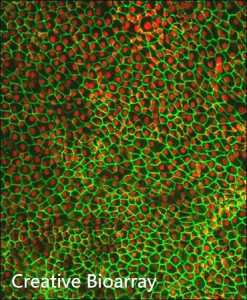What Is Retinal Pigment Epithelium ?

Retinal pigment epithelium (RPE) is the pigmented cell layer outside the neurosensory retina, which nourishes retinal visual cells, firmly attached to the underlying choroid and overlying retinal visual cells. The retinal pigment epithelium is essential for visual function of eyes.
RPE has several functions related to:
- Transport of nutrients, ions, and water
- Absorption of light and protection against photooxidation
- Visual cycle
- Phagocytosis of shed photoreceptor membranes
- Secretion of essential factors for the structural integrity of the retina
- Immune privilege of eyes
RPE can absorbs the light energy focused by the lens on the retina and transports ions, water, and metabolic end products from the subretinal space to the blood . They can deliver nutrients such as glucose and retinol, mainly taken from the blood, to photoreceptors to maintain the excitability of photoreceptors. The phagocytosis of shed photoreceptor outer segments is its another function in the maintenance of photoreceptor excitability. In addition, the RPE is capable of secreting a variety of growth factors helping to maintain the structural integrity of choriocapillaris endothelium and photoreceptors, which also plays an important role in establishing the immune privilege of the eye. A failure in any of those functions may contribute to blindness.
RPE can produce many of the components of the extracellular matrix in vivo. This function is important in the maintenance of a physical barrier to sub-retinal neovascularization, and may also play a role in proliferative vitreoretinopathy. These cells of human eyes can also constitute a part of the retina. They constitutes mostly the outer blood-retinal barrier (BRB). The inner BRB is mainly constituted by endothelial cells. And the tight junctions between neighboring RPE cells and neighboring endothelial cells are essential in the strict control of fluids and solutes that cross the BRB and the prevention the entrance of toxic molecules and plasma components into the retina.
Besides, the RPE stabilizes ion composition in the subretinal space, which is crucial for the maintenance of photoreceptor excitability. In addition, the RPE contributes to the immune privileged status of the eye as part of the BRB by the secretion of immunosuppressive factors inside the eye. Many in vitro studies have confirmed that RPE plays an important role in immune responses due to its ability to express major histocompatibility complex (MHC) molecules, adhesion molecules, FasL and cytokines.
The study on RPE is also very popular in the research area and the two most commonly used in vitro models of the retinal pigment epithelium are fetal human RPE (fhRPE) and ARPE-19 cells. However, the challenge in the use of primary cultures and the contamination by other cells limit the investigation of human RPE cells.
Creative Bioarray, as one of the world’s leading cell products supplier, produces the world's most comprehensive list of research-use cells, including tumor cells, primary cells, stem cells and transformed cells. We maintain various human and animal tumor cell lines that are invaluable for medical, scientific and pharmaceutical institutions.
You may get human RPE cells at:
http://www.creative-bioarray.com/Human-Retinal-Pigment-Epithelial-Cells-CSC-C1530-item-39346.htm

Your email address will not be published. Required fields are marked *